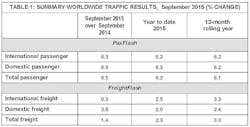Passenger traffic up: Middle East, China, India achieve double-digit growth
Passenger traffic increased by 6.5 percent year over year; while international and domestic traffic posted growth rates of 6.3 and 6.9 percent, respectively, for the month of September.
Middle Eastern airports reported the greatest increase in passenger traffic with double-digit gains of 15.7 percent. Doha (DOH) and Abu Dhabi (AUH), two of the region's major hubs, grew by 21.4 and 18.2 percent, respectively. Dubai (DXB), the world's busiest international airport, grew by 8.2 percent in total passenger traffic year over year.
Except for Africa, which experienced a drop of 1.5 percent in passenger traffic, all regions posted large gains in passenger traffic. Although major airports such as Johannesburg (JNB) and Cairo (CAI) experienced gains of 6.9 and 7.4 percent, respectively, ongoing security concerns in Northern African states have left the region's air transport demand in a weakened state. Tunisian airports such as Tunis (TUN) and other major Egyptian airports were in decline for the month of September.
Growth in airport passenger traffic in the Euro area and the United States has continued on an upward trajectory in tandem with the recovery in advanced economies. A substantive strengthening of domestic demand in both European and North American air travel markets has resulted in overall growth of 6.1 and 6.8 percent, respectively, for the month of September. Similarly, strong growth of 6.5 percent in passenger traffic was attained across airports in the Asia-Pacific region. Many airports in China and India continue to report significant gains in year-over-year passenger numbers. Shanghai (PVG) and New Delhi (DEL) grew by 15.8 and 12.8 percent, respectively.
Air freight markets remain relatively weak as compared to passenger traffic. An emerging market slowdown led by China has resulted in more subdued growth in air freight volumes across the world's markets. Global air freight volumes increased by 1.4 percent year over year for the month of September. On a year-to-date basis, volumes rose by 2.3 percent across the globe for the first three quarters of 2015. Hong Kong (HKG), the world's major international freight hub, reported modest gains of 1.1 percent in September. The major Chinese hubs, Shanghai (PVG) and Beijing (PEK), were flat with respect to year-over-year changes in volumes. The Asia-Pacific region as a whole experienced a slight gain of 0.5 percent in air freight traffic in September.
On the other hand, in the midst of stronger economic fundamentals in advanced economies, North American air freight hubs achieved the greatest gains in volumes for the month of September. With growth of 4.4 percent in air freight volumes, much of the cargo increases in the region can be attributed to the boost in internal domestic demand. Whereas North America's international freight inched up by only 0.9 percent, the region's domestic air freight market grew by 6.9% year over year in September. Memphis (MEM), a major FedEx hub, and Louisville (SDF), the UPS hub, each experienced an increase of 5.7 and 6.6 percent, respectively, in terms of year-over-year growth in volumes.
Airports Council International (ACI), the only worldwide association of airports, has 591 member airport authorities, which operate 1,850 airports in 173 countries. ACI's mission is to promote professional excellence in airport management and operations, and this mandate is carried out through the organization's multiple training opportunities, as well as the customer service benchmarking program, a wide range of conferences, industry statistical products, and best practice publications.
You might also like:
Subscribe today to receive all the latest aerospace technology and engineering news, delivered directly to your e-mail inbox twice a week (Tuesdays and Thursdays). Sign upfor your free subscription to the Intelligent Inbox e-newsletter at http://www.intelligent-aerospace.com/subscribe.html.
Connect with Intelligent Aerospace on social media: Twitter (@IntelligentAero), LinkedIn,Google+, and Instagram.




